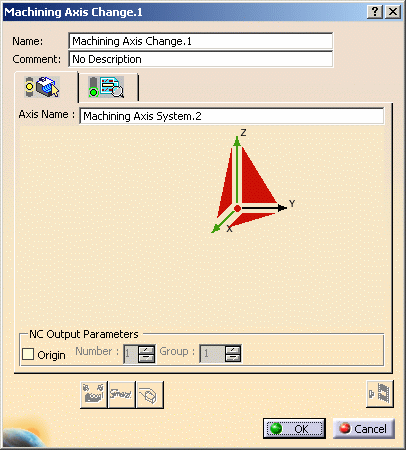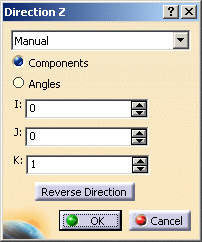Output coordinates are computed in the current machining axis system as shown in the example below.
Tool path computed in machining axis system AXS1 with origin (0,0,0):
$$*CATIA0
$$*AXS1
$$ 1.00000 0.00000 0.00000 0.00000
$$ 0.00000 1.00000 0.00000 0.00000
$$ 0.00000 0.00000 1.00000 0.00000
GOTO/ -40.00000, -30.00000, 20.00000
GOTO/ -40.00000, 30.00000, 20.00000
Same tool path computed in machining axis system AXS2 with origin (0,0,20):
$$*CATIA0
$$*AXS2
$$ 1.00000 0.00000 0.00000 0.00000
$$ 0.00000 1.00000 0.00000 0.00000
$$ 0.00000 0.00000 1.00000 20.00000
GOTO/ -40.00000, -30.00000, 0.00000
GOTO/ -40.00000, 30.00000, 0.00000
The corresponding dialog box is displayed directly at the Geometry
tab ![]() .
.

The X and Z axes are shown already defined (green) because, by default, they are set to the corresponding directions of the absolute axis system. You can define a new machining axis system by specifying new axis orientations as described below.
You can define your axis system with the help of the sensitive icon in the dialog box.
- right-click the symbol representing the origin in the sensitive icon
- select the Coordinates contextual command
- enter the point coordinates in the dialog box that appears.
Coordinates are expressed in the absolute axis system.
The following dialog box appears.

- Manual. In this case, choose one of the following:
- Components to define the orientation by means of I, J and K components
- Angles to define the orientation by means of a rotation
specified by means of one or two angles:
Angle 1 about X, Angle 2 about Y
Angle 1 about Z, Angle 2 about X
Angle 1 about Y, Angle 2 about Z
- Selection. In this case just select a line or linear edge to define the orientation.
- Points in the View. In this case just select two points to define the orientation.
Just click OK to accept the specified orientation.
The specified origin along with the X and Z axes are sufficient to define the machining axis system.
For certain machine types it may be useful to specify an origin number and group. This will result in the following type of output syntax:
$$*CATIA0
$$Origin.1
$$ 1.00000 0.00000 0.00000 0.00000
$$ 0.00000 1.00000 0.00000 0.00000
$$ 0.00000 0.00000 1.00000 0.00000
ORIGIN/ 0.00000,0.00000,0.00000, 1, 1
This output is for an origin with coordinates (0,0,0) and whose origin number and group are both equal to 1.
- Select the Initialize from PP words table check box to consult the Machining Axis Change syntax defined in the PP table that is referenced by the Part Operation.
- Otherwise, enter a PP instruction for your machining axis change. This user-defined syntax has no link with the PP table and its validity is not checked by the program.
- It is possible to analyze the geometry referenced by a machining axis system. This geometry may be a point, line, surface, or an axis defined in the design part. Right-click any sensitive area in the dialog box, and select Analyze. The Geometry Analyser dialog box appears giving the referenced geometry, its name and status.
- A machining axis system can be shared by several machining axis change operations. Machining axis systems can be listed in Manufacturing View using the Sort by Features command.
![]()